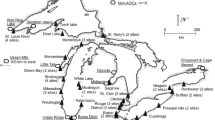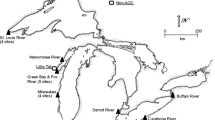Abstract
Extremely high concentrations of cadmium (3.5 μg/g dry wgt.) and elevated concentrations of chromium (>10 μg/g dry wgt.) and mercury (1.6 μg/g dry wgt.) were reported in waterbird tissues at Agassiz National Wildlife Refuge in northwestern Minnesota in 1994. Tree swallows (Tachycineta bicolor) were studied during 1998–2001 at three drainages into the Refuge, two pools on the Refuge, and at a nearby reference location to document whether high levels of contaminants were still present, and if so to quantify the source and severity of the contamination. Trace elements were measured in tree swallow eggs, livers, and diet. Reproductive success and bioindicator responses were monitored. In 2000, water was drawn down on Agassiz Pool, one of the main pools on the Refuge. This presented an opportunity to evaluate the response of trace element concentrations in the diet and tissues of tree swallows after reflooding. High concentrations of trace elements were not detected in swallow tissues, nor were there differences among locations. Less than 20% of swallow samples had detectable concentrations of cadmium or chromium. Mercury concentrations were low and averaged <0.25 μg/g dry wgt. in swallow tissues. Trace elements, including mercury, did not increase in tree swallows following the 2000 drawdown at Agassiz Pool. Hatching success and survival of nestlings to 12 days-of-age for tree swallows on the Refuge were similar to the national average and consistent with background trace element concentrations. Bioindicator measurements were within the normal ranges as well.
Similar content being viewed by others
References
Annual Water Plan: 2001, Agassiz National Wildlife Refuge, Middle River, MN, USA. Station Files.
Aust, S. D.: 1985, ‘Lipid peroxidation’, in: R. A. Greenwald (ed), Handbook of Methods for Oxygen Radical Research, CRC, Boca Raton, FL, USA, pp. 203–207.
Blancher, P. J. and McNicol, D. K.: 1991, ‘Tree swallow diet in relation to wetland acidity’, Can. J. Zool. 69, 2629–2637.
Blus, L. J., Henny, C. J., Hoffman, D. J. and Grove, R. A.: 1995, ‘Accumulation in and effects of lead and cadmium on waterfowl and passerines in northern Idaho’, Environ. Pollut. 89, 311–318.
Burger, J. and Gochfeld, M.: 1994, ‘Franklin's gull (Larus pipixcan)’, in: A. Poole and F. Gill (eds), The Birds of North America, No. 116, Academy of Natural Sciences, Philadelphia, PA, USA, pp. 28.
Burger, J. and Gochfeld, M.: 1996a, ‘Heavy metal and selenium levels in birds at AgassizNational Wildlife Refuge, Minnesota: Food chain differences’, Environ. Monit. Assess. 43, 267–282.
Burger, J. and Gochfeld, M.: 1996b, ‘Heavy metal and selenium levels in Franklin's gull (Larus pipixcan) parents and their eggs’, Arch. Environ. Contam. Toxicol. 30, 487–491.
Burger, J. and Gochfeld, M.: 1999, ‘Heavy metals in Franklin's gull tissues: Age and tissue differences’, Environ. Toxicol. Chem. 18, 673–678.
Clarke, K. R. and Warwick, R. M.: 1994, Change in Marine Communities: An Approach to Statistical Analysis and Interpretation, 2nd edn, Plymouth Marine Laboratories, Plymouth, United Kingdom.
Custer, T. W., Hines, R. H., Melancon, M. J., Hoffman, D. J., Bickham, J. W., Martin, J. W. and Henshel, D.: 1997, ‘Contaminant concentrations and biomarker response in great blue heron eggs from 10 colonies on the upper Mississippi River, USA’, Environ. Toxicol. Chem. 16, 260–271.
Custer, T. W., Custer, C. M., Hines, R. H., Sparks, D. W., Melancon, M. J., Hoffman, D. J., Bickham, J. W. and Wickliffe, J. K.: 2000, ‘Mixed-function oxygenases, oxidative stress, and chromosomal damage measured in lesser scaup wintering on the Indiana Harbor Canal’, Arch. Environ. Toxicol. Chem. 38, 522–529.
Custer, T. W., Custer, C. M., Dickerson, K., Allen, K., Melancon, M. J. and Schmidt, L. J.: 2001, ‘Polycyclic aromatic hydrocarbons, aliphatic hydrocarbons, trace elements and monooxygenase activity in birds nesting on the North Platte River, Casper, Wyoming, USA’, Environ. Toxicol. Chem. 20, 624–631.
Custer, C. M., Custer, T. W., Archuleta, A. S., Coppock, L. C., Swartz, C. D. and Bickham, J.W: 2003a, ‘A mining impacted stream: Exposure and effects of lead and other trace elements on tree swallows (Tachycineta bicolor) nesting in the upper Arkansas River basin, Colorado’, in: Hoffman et al. (eds), Handbook of Ecotoxicology, Volume 2, Lewis Publishers, Boca Raton, FL, USA, pp. 787–812.
Custer, C. M., Custer, T. W., Dummer, P. M. and Munney, K. L.: 2003b, ‘Exposure and effects of chemical contamination on tree swallows nesting along the Housatonic River, Berkshire County, MA, USA, 1998–2000’, Environ. Toxicol. Chem. 22, 1605–1621.
Custer, C. M., Custer, T. W., Rosiu, C. J., Melancon, M. J., Bickham, J. W. and Matson, C. W.: 2005, ‘Exposure and effects of 2,3,7,8-tetrachlorodibenzo-p-dioxin in tree swallows (Tachycineta bicolor) nesting along the Woonasquatucket River, Rhode Island’, Environ. Toxicol. Chem. 93–109.
Dunn, P. O., Thusius, K. J., Kimber, K. and Winkler, D. W.: 2000, ‘Geographic and ecological variation in clutch size of tree swallows’, Auk 117, 215–221.
Eisler, R.: 1985, ‘Cadmium hazards to fish, wildlife, and invertebrates: A synoptic review’, U S. Fish Wildl. Serv. Biol. Rep. 85(1.2), 60.
Eisler, R.: 1986, ‘Chromium hazards to fish, wildlife, and invertebrates: A synoptic review’, U.S. Fish Wildl. Serv. Biol. Rep. 85(1.6), 60.
Eisler, R.: 1987, ‘Mercury hazards to fish, wildlife, and invertebrates: A synoptic review’, U.S. Fish Wildl. Serv. Biol. Rep. 85(1.10), 63.
Fairchild, W. L., Muir, D. C.G., Currie, R. S. and Yarechewski, A. L.: 1992, ‘Emerging insects as a biotic pathway for movement of 2,3,7,8-tetrachlorodibenzofuran from lake sediments’, Environ. Toxicol. Chem. 11, 867–872.
Furness, R. W.: 1996, ‘Cadmium in birds’, in: W. N. Beyer, G. H. Heinz, and A. W. Redmon-Norwood (eds), Environmental Contaminants in Wildlife, Interpreting Tissue Concentrations, CRC Press/Lewis Publishers, Boca Raton, FL, USA, pp. 389–404.
Gerrard, P. M. and St. Louis, V. L.: 2001, ‘The effects of experimental reservoir creation on the bioaccumulation of methylmercury and reproductive success of tree swallows (Tachycineta bicolor)’, Environ. Sci. Technol. 35, 1329–1338.
Griffith, O. W.: 1980, ‘Determination of glutathione and glutathione disulfide using glutathione reductase and 2-vinyl pyridine’, Anal. Biochem. 106, 207–212.
Henny, C. J., Hill, E. F., Hoffman, D. J., Spalding, M. G. and Grove, R. A.: 2002. ‘Nineteenth century mercury: Hazard to wading birds and cormorants of the Carson River, Nevada’, Ecotoxicology 11, 213–231.
Hensler, G. L. and Nichols, J. D.: 1981, ‘The Mayfield method of estimating nesting success: A model, estimators and simulation results’, Wilson Bull. 93, 42–53.
Hoffman, D. J., Heinz, G. H. and Krynitsky, A. J.: 1989, ‘Hepatic glutathione metabolism and lipid peroxidation in response to excess dietary selenomethionine and selenite in mallard ducklings’, J. Toxicol. Environ. Health 27, 263–271.
Hoffman, D. J. and Heinz, G. H.: 1998, ‘Effects of mercury and selenium on glutathione metabolism and oxidative stress in mallard ducks’, Environ. Toxicol. Chem. 17, 161–166.
Hoffman, D. J., Ohlendorf, H. H., Marn, C. M. and Pendleton, G. W.: 1998, ‘Association of mercury and selenium with altered glutathione metabolism and oxidative stress in diving ducks from the San Francisco Bay region, USA’, Environ. Toxicol. Chem. 17, 167–172.
Hussell, C. J. T. and Quinney, T. E.: 1987, ‘Food abundance and clutch size of tree swallows Tachycineta bicolor’, Ibis 129, 243–258.
Kelly, C. A. et al.: 1997, ‘Increases in fluxes of greenhouse gases and methyl mercury following flooding of an experimental reservoir’, Environ. Sci. Techol. 31, 1334–1344.
King, K. A., Custer, T. W. and Weaver, D. A.: 1994, ‘Reproductive success of barn swallows nesting near a selenium-contaminated lake in east Texas, USA’, Environ. Pollut. 84, 53–58.
Kraus, M. L.: 1989, ‘Bioaccumulation of heavy metals in pre-fledgling tree swallows, Tachycineta bicolor’, Bull. Environ. Contam. Toxicol. 43, 407–414.
Mayfield, H.: 1961, ‘Nesting success calculated from exposure’, Wilson Bull. 73, 255–261.
Mayfield, H.: 1975, ‘Suggestions for calculating nest success’, Wilson Bull. 87, 456–466.
Mengelkoch, J. M., Niemi, G. J. and Regal, R. R.: 2004, ‘Diet of the nestling tree swallow’, Condor 106, 423–429.
Quinney, T. E. and Ankney, C. D.: 1985, ‘Prey size selection by tree swallows’, Auk 102, 245–250.
Robertson, R. J., Stutchbury, B. J. and Cohen, R. R.: 1992, ‘Tree swallow (Tachycineta bicolor)’ in: A. Poole, P. Stettenheim and F. Gill (eds), The Birds of North America, No. 11, Academy of Natural Sciences, Philadelphia, PA, USA, pp. 26.
Sanz, J. J.: 1998, ‘Effects of geographic location and habitat on breeding parameters of great tits’, Auk 115, 1034–1051.
Sauer, J. R. and Williams, B. K.: 1989, ‘General procedures for testing hypotheses about survival or recovery rates’, J. Wildl. Manage. 53, 137–142.
Scheuhammer, A. M.: 1987, ‘The chronic toxicity of aluminum, cadmium, mercury, and lead in birds: A review’, Environ. Pollut. 46, 263–295.
Sedlak, J. and Lindsay, R. H.: 1968, ‘Estimate of total, protein-bound, and nonprotein sulfhydryl groups in tissue with Ellmans' reagent’, Anal. Biochem. 25, 192–205.
Tietze, F.: 1969, ‘Enzymic method for quantitiative determination of nanogram amounts of total and oxidized glutathione’, Anal. Biochem. 27, 502–522.
Vindelov L. L., Christensen, I. J. and Nissen, N. I.: 1983, ‘A detergent-trypsin method for the preparation of nuclei for flow cytometric DNA analysis’, Cytometry 3, 323–327.
Wiener, J. G., Krabbenhoft, D. F., Heinz, G. F. and Scheuhammer, A. M.: 2003, ‘Ecotoxicology of mercury’, in: D. J. Hoffman, B. A. Rattner, G. A. Burton Jr. and J. Cairns Jr. (eds), Handbook of Ecotoxicology, Volume 2, Lewis Publishers, Boca Raton, FL, USA, pp. 409–463.
Yauk, C. L. and Quinn, J. S.: 1996, ‘Multilocus DNA fingerprinting reveals high rate of heritable genetic mutation in herring gulls nesting in an industrialized urban site’, Proc. Natl. Acad. Sci. 93, 12137–12141.
Author information
Authors and Affiliations
Corresponding author
Rights and permissions
About this article
Cite this article
Custer, C.M., Custer, T.W., Warburton, D. et al. Trace Element Concentrations and Bioindicator Responses in Tree Swallows from Northwestern Minnesota. Environ Monit Assess 118, 247–266 (2006). https://doi.org/10.1007/s10661-006-1499-1
Received:
Accepted:
Issue Date:
DOI: https://doi.org/10.1007/s10661-006-1499-1




